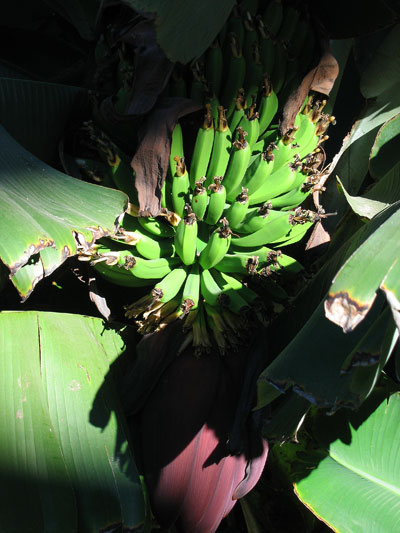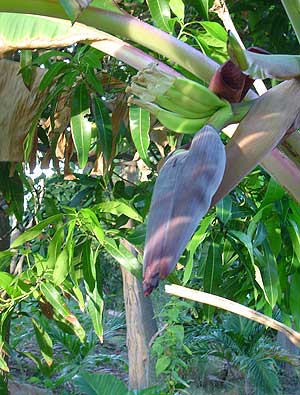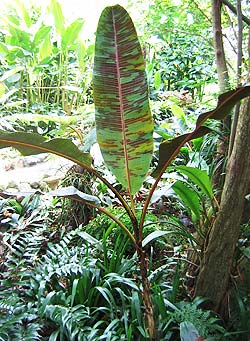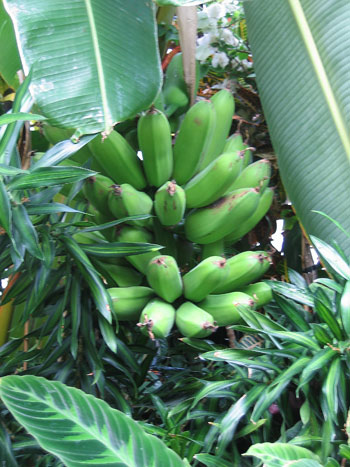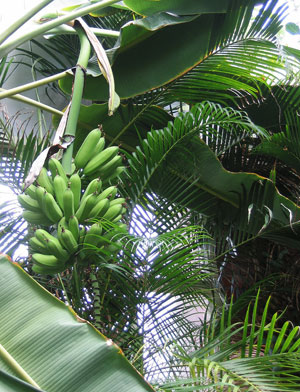| GreenGardeningCookingCuring.com |
| HOME |
| Tour Our Destination Websites | Taxco-Today.com | Oaxaca-Today.com | Montserrat-Today Site |
| See our silver designs at Krika.com | Read our travel stories and other tales at Krika.com |
|
|
 **Banana (Normal
sweet eating variety) Musa acuminata or Musa spp or Musa sapientum **Banana (Normal
sweet eating variety) Musa acuminata or Musa spp or Musa sapientum Bananas are one of the prettiest and most exotic plants in the garden if you can find a place for them out of the wind. Winds quickly tear the huge green leaves to shreds. The plants yield a great amount of fruit periodically on one stem. After about five years, new plants have to replace the old. Depending on the variety you plant they will grow to a height of twenty to thirty feet. Benefits: 1. Bananas contain the minerals potassium and magnesium which in recent studies are said to correlate positively with bone strength. 2. If you have an upset stomach, eat a banana; it may help. 3. Yahoo News has this to contribute to the list of bananas benefits, "The banana is an excellent source of potassium and dietary fiber. It's also one of the few fruits that contain the full range of B vitamins. Besides keeping good intestinal balance, this tropical fruit is said to be a great cure for hangovers." The latest I've heard about bananas is that their ample B vitamins can boost testosterone. That means men can stop using that awful testosterone enhancing chemical under their arms risking the women and children in their lives. Now they can just eat a banana to do the same job. Sounds good to me. Insects and Diseases: We have found that bananas on our property are especially subject to infestations of nematodes which though unseen cause a rotting of the base of the banana plant under the soil surface. Normal procedures we've been told include digging up the infected plants and soaking them in what are very toxic nematocides. That didn't seem at all appealing, but planting marigolds by the hundreds helped a great deal. It was a slower, but longer lasting and much safer cure. Bananas are not plagued by many insects except the banana borer. Photographed: In our banana garden at our former home in Montserrat. Text & Photographs Copyrighted ©KO 2004/2007 |
|||
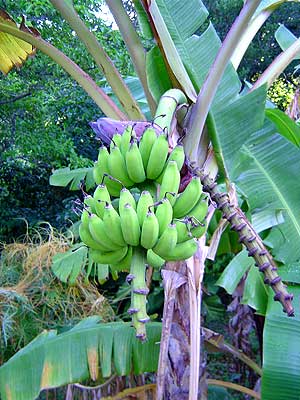 FIND
PHOTOGRAPH FIND
PHOTOGRAPH**Baby Sweet Bananas Variety Unknown This banana plant was a gift from a departing expatriate and we had no idea what it was. What we do know is that it was delicious and very sweet. The photograph taken two weeks after the one on the left and you can see how quickly the fruit develops. Photographed: Beside our young mango tree at our former home in Montserrat. Text and Photographs Copyrighted ©KO 2007 |
|||
|
|||
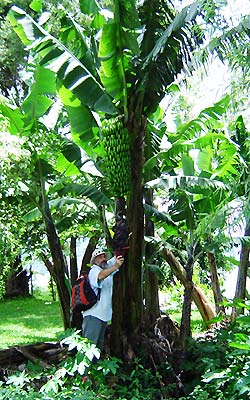 Lake
Atitlan Bananas I don't know what variety this banana plant is, but take a look at how tall it
is and the quantity of ripening bananas on this one plant. Lake
Atitlan Bananas I don't know what variety this banana plant is, but take a look at how tall it
is and the quantity of ripening bananas on this one plant.Photographed: In the village of San Marcos on Lake Atitlan in Guatemala Text and Photograph Copyrighted ©KO 2010 |
|||
| Mother
Banana or in Spanish Madre Banano This banana was growing along side the country dirt road that we took in the mornings when we were going shopping in the town market. It is very tall and has a hugely thick trunk as you can see in the photograph to the left, but it didn't strike us as unusual until it put out its flower which is unlike any other banana flower we've seen. Look at the photograph on the right. We asked a local fellow passing by what it is called and he said, "Madre Banano," with a good deal of respect for this prolific banana plant. Photographed: Along the roadside in Hacienda San Buenaventura in Guatemala in May 2010. Planting and Care: I don't yet know about the planting of this unusual banana, but we were told that it will produce for more than two decades. All of the banana and plantain plants that we know produce bananas once and then produce side shoot plants that will also each produce bananas only once before dying. As it turns out the bananas produced on this plant are small, only about six inches long and they are full of watermelon sized seeds so it is not as attractive a plant as we first thought. Text and Photographs Copyrighted ©KO 2010 |
|||
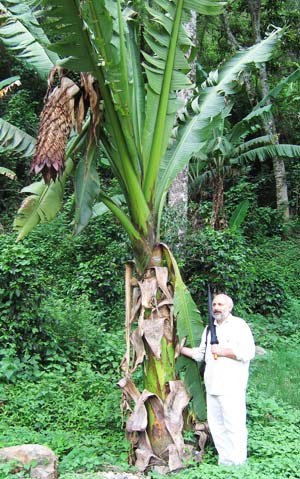 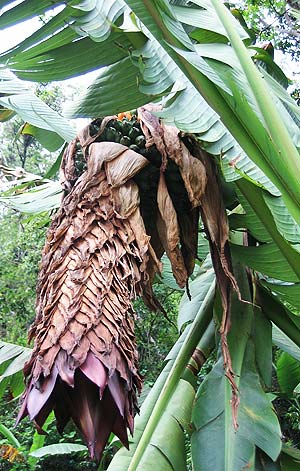 |
|||
| **Plantain Musa
paradisiaca L. This is the heavy cooking banana plant and its name, plantain, is an African word for banana. We call them platanos machos in Mexico to distinguish them from sweet eating bananas. It has been said that a plot of ground that will grow 50 pounds of wheat or 100 pounds of potatoes will grow 4000 pounds of plantains. Since they can be eaten in so many ways, it seems a shame they are not even more widely used. We particularly like them aged till the skin turns black, then peeled, fried in butter and served with pork or mixed into a curried rice dish. Photographed: In our banana garden at our former home in Montserrat. Text and Photographs Copyrighted ©KO 2007/2010 |
|||
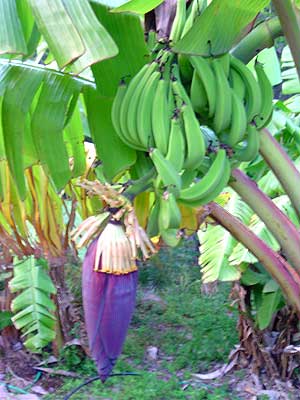 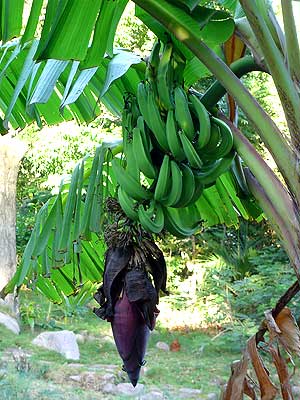 |
|||
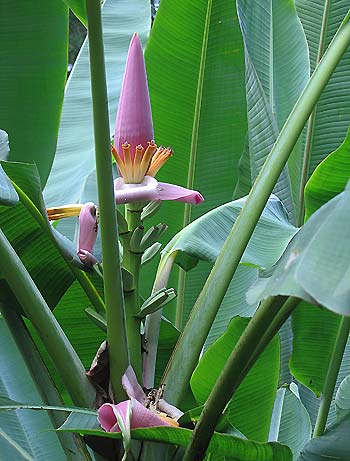  Pink
Banana (1) Musa textilis or Musa velutina Pink
Banana (1) Musa textilis or Musa velutinaAs you'll see in the photographs this is a beautiful banana plant when in flower and it has the rare characteristic of growing its beautiful small pink bananas straight up. Sadly the fruit is inedible. From: The Himalayan Tropics Photographed: In the Botanical Garden at Hotel Atitlan on Lake Atitlan in Guatemala. Text & Photographs Copyrighted ©Krika.com 2010 |
|||
| Pink
Banana (2) Photographed: In the Royal Botanical Garden in Sydney, Australia, 2013. Text & Photographs Copyrighted ©GreenGardeningCookingCuring. com 2013 |
|||
Pink
Banana (2) Photographed: In the Royal Botanical Garden in Sydney, Australia, 2013. Text & Photographs Copyrighted ©GreenGardeningCookingCuring. com 2013 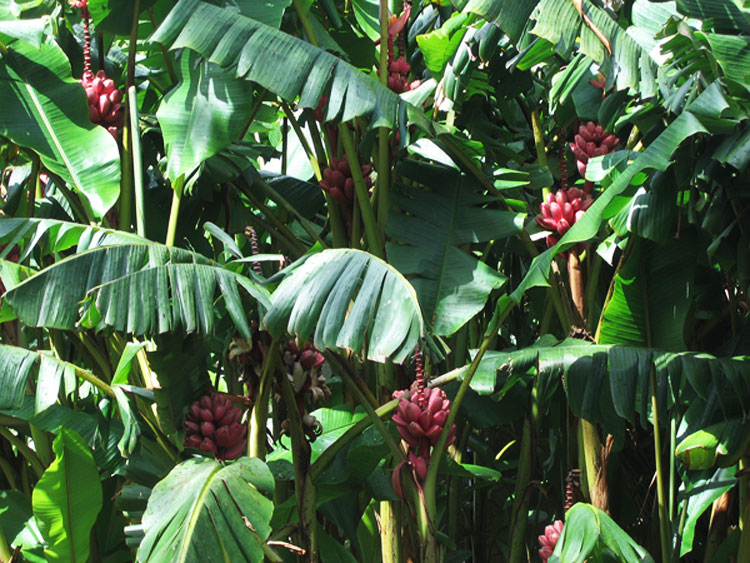 |
|||
|
|||
|
|
